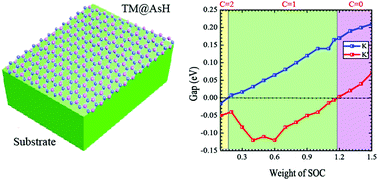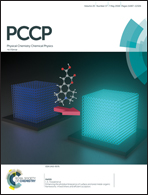Quantum anomalous/valley Hall effect and tunable quantum state in hydrogenated arsenene decorated with a transition metal
Abstract
The quantum anomalous Hall (QAH) effect is superior to the quantum spin Hall (QSH) effect, which can avoid the inelastic scattering of two edge electrons located on one side of a topological nontrivial material, and thus it has attracted both theoretical and experimental interest. Here, we systematically investigate the lattice structures, and electronic and magnetic properties of hydrogenated arsenene decorated with certain transition metals (Cr, Mo and Cu) based on density-functional theory. A unique QAH effect in Mo@AsH is predicted, whose Chern number (C = 1) indicates only one chiral edge channel located on its one side. Then, we prove that this QAH effect realization is closely related with band inversion, which is the competitive result between its spin–orbit coupling (SOC) strength and exchange field. The quantum state of Mo@AsH can also be tuned by an external strain, similar to SOC, and it is noted that its increased topological gap of about 35 meV under 5.0% tensile strain, is large enough to realize the QAH effect at room-temperature. Additionally, the quantum valley Hall effect in Cu@AsH contributed by the inequality of AB sublattices is also found. Our results reveal the physical mechanism to realize the QAH effect in TM@AsH and provide a platform for electrically controllable topological states, which are highly desirable for nanoelectronics and spintronics.



 Please wait while we load your content...
Please wait while we load your content...